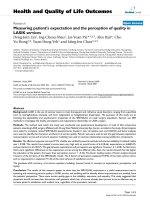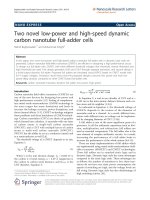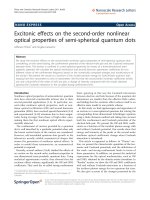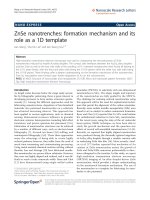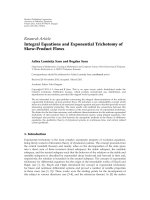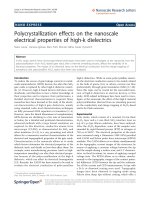báo cáo hóa học:" Ultrasonication effects on thermal and rheological properties of carbon nanotube suspensions" pot
Bạn đang xem bản rút gọn của tài liệu. Xem và tải ngay bản đầy đủ của tài liệu tại đây (7.07 MB, 28 trang )
This Provisional PDF corresponds to the article as it appeared upon acceptance. Fully formatted
PDF and full text (HTML) versions will be made available soon.
Ultrasonication effects on thermal and rheological properties of carbon
nanotube suspensions
Nanoscale Research Letters 2012, 7:127 doi:10.1186/1556-276X-7-127
Binglu Ruan ()
Anthony M Jacobi ()
ISSN 1556-276X
Article type Nano Express
Submission date 5 August 2011
Acceptance date 14 February 2012
Publication date 14 February 2012
Article URL />This peer-reviewed article was published immediately upon acceptance. It can be downloaded,
printed and distributed freely for any purposes (see copyright notice below).
Articles in Nanoscale Research Letters are listed in PubMed and archived at PubMed Central.
For information about publishing your research in Nanoscale Research Letters go to
/>For information about other SpringerOpen publications go to
Nanoscale Research Letters
© 2012 Ruan and Jacobi ; licensee Springer.
This is an open access article distributed under the terms of the Creative Commons Attribution License ( />which permits unrestricted use, distribution, and reproduction in any medium, provided the original work is properly cited.
- 1 -
Ultrasonication effects on thermal and rheological properties of
carbon nanotube suspensions
Binglu Ruan*
1,2
and Anthony M Jacobi
1
1
Mechanical Science and Engineering, University of Illinois, Urbana, IL, 61801-2906,
USA
2
Department of Thermal Engineering, Tsinghua University, Beijing, 100084, China
*Corresponding author:
Email addresses:
BR:
AMJ:
Abstract
The preparation of nanofluids is very important to their thermophysical properties.
Nanofluids with the same nanoparticles and base fluids can behave differently due to
different nanofluid preparation methods. The agglomerate sizes in nanofluids can
significantly impact the thermal conductivity and viscosity of nanofluids and lead to a
different heat transfer performance. Ultrasonication is a common way to break up
agglomerates and promote dispersion of nanoparticles into base fluids. However,
research reports of sonication effects on nanofluid properties are limited in the open
literature. In this work, sonication effects on thermal conductivity and viscosity of
carbon nanotubes (0.5 wt%) in an ethylene glycol-based nanofluid are investigated.
The corresponding effects on the agglomerate sizes and the carbon nanotube lengths
are observed. It is found that with an increased sonication time/energy, the thermal
conductivity of the nanofluids increases nonlinearly, with the maximum enhancement
of 23% at sonication time of 1,355 min. However, the viscosity of nanofluids
increases to the maximum at sonication time of 40 min, then decreases, finally
approaching the viscosity of the pure base fluid at a sonication time of 1,355 min. It is
also observed that the sonication process not only reduces the agglomerate sizes but
also decreases the length of carbon nanotubes. Over the current experimental range,
the reduction in agglomerate size is more significant than the reduction of the carbon
nanotube length. Hence, the maximum thermal conductivity enhancement and
minimum viscosity increase are obtained using a lengthy sonication, which may have
implications on application.
Introduction
Thermal conductivity and viscosity of a heat transfer fluid play an important role in
efficiency improvement of thermal equipment and systems as: air-conditioning and
refrigeration, transportation, electronic cooling, heating and ventilating, etc.
Researchers have found many ways to enhance the thermal conductivity of a heat
transfer fluid, including suspending solid particles into the fluid. However,
micrometer or millimeter-sized particles suspended in the fluid usually settle and can
cause corrosion and abrasion to the components and systems. Recently, developments
in nanotechnology made nanometer-sized particles available. In 1995, Choi and
Eastman [1] firstly introduced the nanometer-sized particles (nanoparticles) into heat
transfer fluids and coined the term ‘nanofluid.’
- 2 -
Many researchers found that dispersing a small amount of nanoparticles into a heat
transfer fluid can enhance its thermal conductivity dramatically, and the enhancement
could be beyond that expected from the conventional mixing theory, such as Maxwell
theory [2] and Hamilton-Crosser theory [3]. Eastman et al. [4] observed a 40%
thermal conductivity by dispersing 0.3 vol% copper nanoparticles into ethylene
glycol. Choi et al. [5] investigated the thermal conductivity of carbon nanotube-oil
suspensions and obtained a 150% enhancement for the nanofluid with a concentration
of 1.0%. Das et al. [6] explored temperature effects on the thermal conductivity
enhancement of nanofluids and found that dispersion of nanoparticles into the fluid
can significantly enhance its thermal conductivity, and a larger enhancement can be
observed at an elevated temperature. For the viscosity of nanofluids, some researchers
found no significant change compared to the base fluid [7]. However, other
researchers also noticed a remarkable increase in viscosity for the fluid with
nanoparticles. Murshed et al. [8] observed 60% and 80% viscosity increases for
Al
2
O
3
-water and TiO
2
-water nanofluids with concentrations of 3 vol%, which is more
significant than the predictions of Krieger-Dougherty's [9] and Nielsen's models [10].
The viscosity of Al
2
O
3
-water nanofluids prepared by Pak and Cho [11] was almost
three times higher than that of pure water. Ruan and Jacobi [12] obtained no
significant falling-film convective heat transfer enhancement and attributed it to a
12.5% viscosity increase and 4.6% thermal conductivity enhancement that they had
observed for Al
2
O
3
-water nanofluids with concentrations of up to 2 vol%. Wang et al.
[13] measured the viscosity of the same kind of nanofluids with different dispersion
techniques, and stated that the nanofluid could have a lower viscosity if the particles
were better dispersed. Hence, the nanofluid preparation could be a key to determine
the performance of the nanofluids.
Generally, there are two methods to disperse the nanoparticles into base fluids: a so-
called one-step method and a two-step method [1]. The two-step method is widely
used since a larger amount of nanofluid can be prepared at one time. Moreover, the
two-step method is suitable for nonmetallic nanoparticles and base fluids with high
vapor pressures. When preparing nanofluids by the two-step method, nanoparticles
are dispersed into the base fluid, and then the suspension is treated by a mechanical
method to reduce aggregation in the suspension. Ultrasonication is probably the most
widely used and most effective mechanical technique for this purpose. Many
researches use a bath or tip sonicator to treat their nanofluid samples [14-16];
however, very limited work of ultrasonication effects on the nanofluid preparation is
reported in the open literature. Amrollahi et al. [17] investigated the ultrasonication
time effects on sediment and the thermal conductivity of the carbon nanotube-
ethylene glycol nanofluids and found that thermal conductivity of the nanofluids
increased with sonication time. Yang et al. [18] explored the sonication energy/time
impact on thermal conductivity of nanotube-oil suspensions and observed a decreased
thermal conductivity with an increasing sonication energy/time. They also
investigated the sonication energy effects on steady-shear viscosity of nanotube-oil
suspensions and found that the viscosity decreased with increased sonication energy.
In this study, the ultrasonication effects on thermal conductivity and viscosity of
ethylene glycol-based multiwall carbon nanotube [MWCNT] nanofluids are explored.
(Sun Innovations Inc., Fremont, CA, USA) Optical microscope, scanning electron
microscope [SEM] and transmission electron microscope [TEM] images of samples,
subjected to different sonication times, are used to explore the sonication effects on
- 3 -
the size of agglomerates and the length of the nanotubes, which are significant factors
affecting the thermal conductivity and the viscosity of the nanofluids. The results are
compared to the available literature and possible explanations for the observed
behavior are offered.
Experimental details
Materials
The multiwall carbon nanotubes have nominal outer diameters of 10 to 30 nm, inner
diameters of 5 to 10 nm and lengths of 10 to 30 µm. The MWCNTs were
manufactured by chemical vapor deposition. An SEM micrograph of the MWCNTs as
received is provided in Figure 1.
Nanofluid preparation
Considering that the surface of the carbon nanotube is hydrophobic and ethylene
glycol is a polar liquid, gum arabic was employed as a dispersant in order to better
disperse the carbon nanotubes in the ethylene glycol. When preparing the nanofluid,
the gum arabic at a concentration of 0.25 wt% was first dispersed into the ethylene
glycol in a 500-ml glass breaker, which was placed on a stirrer with a stir bar rotating
inside the fluid; after the gum arabic was fully dissolved into the ethylene glycol, 0.5
wt% MWCNTs were dispersed into the fluid. A tip ultrasonicator was used to treat
the fluid at settings of 150 W both continuously and in pulse 20 mode (0.8 s on and
3.2 s off) at 20 kHz. The ultrasonicator has a timer to set the desired sonication time.
Based on the known volume of the test liquid (500 ml), the specific sonication energy
per minute can be calculated as 1.8 × 10
4
kJ/m
3
. Hence, the sonication energy can be
obtained as the specific sonication energy per minute multiplied by the sonication
time. For the pulse mode, the sonication energy was calculated as the energy at the
continuous mode multiplied by the percentage of the ‘on’ time (e.g., 20% for the
pulse 20 mode). As an initial screening of the effectiveness of sonication, a sonicated
nanofluid and an unsonicated specimen were placed still in the lab for more than 1
week to assess settling. A photograph of the specimens is shown in Figure 2, where it
is shown that a sonicated specimen manifested no significant settling, but an
unsonicated nanofluid had a thick layer of sediment (Figure 2, samples 3 and 4).
Agglomerate and particle size observation
The size of agglomerates in the nanofluids was examined using an optical
microscope. At least four images at different locations were recorded for each
nanofluid sample to ensure the accuracy of the test. The images recorded with the
microscope were analyzed by standard image processing methods, and the average
sizes of agglomerates and their uncertainties were determined. The lengths of
MWCNTs in suspensions at different sonication times were determined using TEM.
Since the quantity of MWCNTs in each TEM sample was limited due to the method
of TEM sample preparation, at least five TEM samples were prepared for each
nanofluid sample and four images for each TEM sample were recorded. The TEM
images were also analyzed using standard image processing methods, and the average
lengths of MWCNTs and their uncertainties were obtained. The standard image
processing methods included pixelization, threshold definition, binary conversion, and
geometry analysis.
- 4 -
Thermal conductivity and viscosity measurements
Thermal conductivity, k, of the suspensions was measured using a manufacturer-
calibrated KD2-pro thermal property meter (Decagon Devices, Pullman, WA, USA)
at the room temperature (20ºC). The instrument is based on the hot-wire method. The
probe (60 mm in length and 1.3 mm in diameter) of the KD2-pro thermal property
meter integrates a heating element and a thermometer. Both the heat output and the
temperature rise of the probe were recorded and sent to a microprocessor to calculate
thermal properties of the test fluid. The uncertainty of the KD2-pro for thermal
conductivity measurement as indicated by the manufacturer is ±5%; however, by
repeating measurements for the same fluid for more than 50 times, it was found that
the repeatability, which is relevant in determining changes in thermal conductivity
was ±3%. Since the MWCNT-ethylene glycol nanofluid behaved as a non-Newtonian
fluid, the viscosity,
µ
, was measured using a stress-controlled rotational rheometer at
20ºC. The system had a torque range of 0.5 µNm-100 mNm, and a resolution of 1
nNm. A 4°/40 mm cone-plate measurement unit was used. The test sample was placed
on the 20°C thermostat plate with the temperature maximum deviation of ± 0.01°C,
after well shaken in the test tube. Once the temperature of the sample reached a steady
state, the measurements were started. As the shear stress was applied, the rotational
speed of the cone and cone dimensions gave the shear rate. The start and end shear
stresses were 0.02 and 5.5 Pa, respectively, and the shear rate range was 10 to
approximately 100 s
−1
. The apparent viscosity was calculated by the power law model.
The measurements were repeated for five times for each test sample to ensure the
accuracy, and the maximum deviation was found to be less than 5%.
Results and discussion
Thermal conductivity
In preliminary experiments, both pulse mode and continuous mode sonications were
used to treat otherwise identical samples and the thermal conductivity of the treated
fluids samples was measured and compared. During sonication at 20 kHz, bubbles are
created and collapsed, and the resulting shock from this cavitation process breaks up
nanotube agglomerates. However, the process also generates heat and the nanofluid
temperature rises, especially in continuous mode sonication. In order to mitigate
evaporation of the base fluid during sonication, a cooling system was employed
during the continuous mode sonication, maintaining a sample temperature at about
20°C. The thermal conductivity data for the two identical samples with different
sonication modes are provided in Figure 3, where each reported measurement is the
average of five readings, and the data have a two-σ precision limit of ±3%. From the
figure, it can be seen that the sonication mode had very little impact on the thermal
conductivity; the differences are within the precision limit. For convenience, pulse
mode sonication was adopted as the standard procedure for later experiments.
The ratio of the nanofluid thermal conductivity to that of the base fluid, k/k
b
, is plotted
against sonication time in Figure 4. The thermal conductivity ratio, k/k
b
, of ethylene
glycol with 0.25 wt% gum arabic only was measured to be 1.02. It can be seen in
Figure 4 that the thermal conductivity of the nanofluid always increased with the
sonication time. The increase in thermal conductivity was more significant during the
first 160 min. After around 22 h of sonication, the thermal conductivity reached a
value 23% larger than that of the base fluid, and the data suggest an asymptotic value
not much larger than that achieved after 22 h. By comparing our data to those of
- 5 -
Amrollahi et al. [17], it can be seen that the thermal conductivity increase in the
current experiments is around 5% larger than that found by Amrollahi et al. [17] for
0.5 wt% MWCNT-ethylene glycol suspensions. The larger increase may be caused by
the dispersant used in the current experiment. Amrollahi et al. [17] dispersed carbon
nanotubes directly into ethylene glycol without any dispersant. Moreover, it was
found in our previous work [19] that an addition of a small amount of gum arabic
itself in pure ethylene glycol slightly increases its thermal conductivity. However, the
thermal conductivity of MWCNT-ethylene glycol suspensions was found to be
insensitive to gum arabic concentrations (from 0.1% to 3%). The variation of the
thermal conductivity of the nanofluid with the ultrasonication input energy per unit
volume is shown in Figure 5. The energy input per unit volume is 1.8 × 10
4
kJ/m
3
for
a sonication time of 5 min at pulse 20 mode.
Viscosity
The rheological behavior of MWCNT-ethylene glycol nanofluids after different
sonication times is shown in Figure 6. The viscosity of the pure ethylene glycol was
recorded before the nanofluid viscosity measurements and compared to the values
from literature to verify the system accuracy. The result shows no dynamic viscosity
change with the shear rate for pure ethylene glycol; however, the results for carbon
nanotube suspensions displayed a shear thinning behavior, which was also observed
by Yang et al [18]. When comparing the rheological behavior of samples subjected to
different sonication times, it is found that the nanofluid with the sonication time of 40
min has the highest viscosity, and its viscosity decreased dramatically (from 4.4 to
0.06 Pa.s) with an increase in shear rate (from 0.1 to 100/s). However, the viscosity of
the sample with the sonication time of 1,355 min displays a more flat viscosity
variation with an increasing shear rate; moreover, at higher shear rates, its viscosity
approached that of the base fluid. This behavior can be observed more clearly in
Figure 7, where the viscosity of the test sample is plotted against the sonication time
at different shear rates. It can be seen from Figure 7 that the viscosity at low shear
rates is larger than that at higher shear rates at a fixed sonication time. It is interesting
that at a fixed shear rate, the viscosity of the nanofluid first increased then decreased
with an increase in sonication time. When the nanofluid is sonicated for around 40
min, the viscosity sharply increased to the maximum, and with further sonication, the
viscosity of the nanofluid decreased gradually until it approached the viscosity of pure
ethylene glycol for long sonication times. The nanofluid viscosity increase,
µ
/
µ
b
, is
plotted against the thermal conductivity ratio, k/k
b
, at different shear rates in Figure 8.
It is clear in Figure 8 that the viscosity increased firstly and decreased, with increased
sonication time and thermal conductivity. Finally, the largest thermal conductivity and
lowest viscosity were obtained by a long sonication time for ethylene glycol-based
MWCNT nanofluids. This finding may be very important for the heat transfer
applications of nanofluids.
Agglomerate size
In order to understand sonication time effects on the thermal conductivity and
viscosity of the MWCNT-ethylene glycol nanofluid, microscopy was employed to
examine the agglomerate size. Images of 6 µl droplets of nanofluids held between two
glass slides are shown in Figure 9; the droplets were subjected to sonication times of
5, 40, 140, 520, and 1,355 min. With an increased sonication time, the agglomerate
size becomes smaller, and the small agglomerates spread more widely with base fluid
between glass slides. Micrographs of these droplets, as shown in Figure 10, confirm
- 6 -
this statement. The magnification from the optical microscope is the same for all
images as shown in Figure 10, and the scale bars correspond to a length of 200 µm.
Images were recorded at four locations for each nanofluid sample (note that the edges
of bubbles are shown in Figure 10a,b). The micrographs were analyzed using standard
image processing, and the average agglomerate sizes were obtained for the samples.
The average agglomerate size for the MWCNT-ethylene glycol nanofluids is shown
as a function of sonication time in Figure 11. From Figures 10 and 11, it is clear that
the agglomerate size in the nanofluids decreased with a longer sonication time.
Smaller agglomerates imply a more uniform dispersion of the nanoparticles, and this
more uniform distribution probably contributes to the increase in thermal conductivity
with sonication time shown in Figures 4 and 5.
In addition to changes in agglomerate size, it is also apparent from Figure 10 that the
morphology of the agglomerates varied with sonication time. In the as-received
condition, the MWCNTs have a large aspect ratio (length/diameter), and they were
highly entangled (see Figure 1). Upon dispersion in the base fluid and sonication, the
agglomerated MWCNTs appear to go through a two-stage morphological change. In
the first stage, sonication appears to loosen the agglomerations, without much impact
on the length of the MWCNTs: Figure 10a,b,c suggest this loosening, as progressively
longer sonication time result in ‘fluffier’ agglomerations, with the appearance of
fragmented MWCNTs in Figure 10c. With lengthier sonication times, a second stage
ensues, and the entangled MWCNTs begin to break: Figure 10c,d,e shows this
process. The viscosity behavior supports this description of a two-phase process. A
loosening of the agglomerations apparently results in an increase in viscosity;
however, once the second stage is entered and the MWCNTs begin to break up, the
viscosity begins to decrease (see Figure 7). These findings are unlikely to be
quantitatively general for other base fluids; i.e., there is no reason to expect that the
increase in conductivity and the maximum increase in viscosity will be quantitatively
the same for other base fluids. However, the trends manifested by the ethylene glycol-
based MWCNT nanofluid are anticipated with other base fluids because the two-stage
process of loosening agglomerations and then breaking up of the MWCNTs is
expected with sonication in other fluids. Therefore, an increasing thermal conductivity
and an increasing then decreasing viscosity with sonication time are expected.
Moreover, it is expected that for a less viscous base fluid, such as water, for the
duration of the first stage might be quite shorter than that of ethylene glycol.
Length of the carbon nanotube
Micrographs obtained from a TEM of the MWCNTs before sonication and after
sonication for 1,355 min are shown in Figure 12a,b, respectively. At least five images
at different locations were recorded and analyzed for each sonication time. Using
standard image analysis methods, the average length of the MWCNTs was determined
for each of the five images, and these values were averaged to obtain an overall
average for each sonication time. Each subfigure in Figure 12 presents two
representative images from two different locations. The results are presented in Figure
13, as the average length of MWCNT in ethylene glycol-based nanofluids plotted
against the sonication time. The average aspect ratio of MWCNT plotted against the
sonication energy input is presented in Figure 14. The aspect ratio of the carbon
nanotube was calculated by dividing the length by the mean diameter of the nanotubes
(20 nm). As shown in Figures 12, 13,14, as the agglomerate size is reduced, the length
of the carbon nanotube is also reduced. According to Pohl et al. [20], the length of the
- 7 -
carbon nanotube can be expressed as a function of the sonication specific energy E
v
(sonication energy per unit volume):
m
v
A
L E
=
(1)
where L is the length of the carbon nanotube, and A and m are constants. Yang et al.
[18] recommended an alternate form of (Equation 1), when the specific energy input
is stable and the volume of dispersion is constant:
n
B
L t
= (2)
where B and n are constants, and t is the sonication time.
The data in Figures 13 and 14 were fit to curves of the forms given by (Equations 1
and 2). The values of the constants and the coefficients of determination, R
2
, are
shown in the figures. The value of n found by Yang et al. [18] was −0.2742, which
differs by 9.6% from that found in the current work; however, this is very likely a
base-fluid effect. Yang et al. [18] employed oil as their base fluid. It should also be
noted that Yang et al. [18] reported a decrease in thermal conductivity due to a
decrease in carbon nanotube length. However, in the current work, the thermal
conductivity increased with an increased sonication time. In the current work and in
the work of Yang et al. [18], the as-received nanotubes had aspect ratios of about 300.
However, due to the different base fluids, the changes in aspect ratio with sonication
energy were different. Yang and co-workers observed a sharp decrease in the aspect
ratio from 300 to 50 with a sonication specific energy input of 2.4 × 10
5
kJ/m
3
. They
also observed an aspect ratio of less than 50 with a sonication specific energy input of
more than 2.4 × 10
5
kJ/m
3
. In contrast, the current data show that with a sonication
specific energy input of 2.4 × 10
5
kJ/m
3
, the aspect ratio decreased from 300 to 215.
Hence, in the current work, the aspect ratio was much larger than that found by Yang
and co-workers, after sonication with the same specific energy input. Even when the
energy input has reached 5 × 10
6
kJ/m
3
, the aspect ratio was larger than 50 in the
current work. Apparently, in the current work, the effect of a decrease in aspect ratio
on thermal conductivity is not strong compared to the thermal conductivity increase
induced by reduction of agglomerate size. Moreover, Figures 13 and 14 suggest that
further sonication treatment (with a sonication specific energy input exceeding 5 × 10
6
kJ/m
3
) may not decrease the aspect ratio significantly, because the aspect ratio
asymptotically approaches a value near 50 with energy input.
Property relations
The data on thermal conductivity and viscosity can be related to agglomerate size and
aspect ratio, and such a model may have value in the application of ethylene glycol-
based MWCNT nanofluids. In using such curve fits, caution should be maintained to
recognize the limitations of the data upon which the curve fits are based: the
nanofluids used a 0.25 wt% of gum arabic, and the MWCNT concentration was fixed
at 0.5 wt%. Relations between the nanofluid thermal conductivity and viscosity and
the MWCNT shape (nanotube aspect ratio and agglomerate size) are presented in
Figures 15 and 16, respectively. Figure 15 shows the thermal conductivity plotted
against the nanotube aspect ratio and agglomerate size at different sonication times. A
curve fit correlation to the data of Figure 15 is shown as (Equation 3); the fit has an
average deviation of 1.7% and the maximum deviation of 3.3% at the large nanotube
aspect ratio and agglomerate size:
0.069
0.2
b
agg
( / )
/ 1.236
L d
k k
D
=
(3)
- 8 -
where D
agg
is the agglomerate size, with the units of micrometer. The viscosity is
plotted against the nanotube aspect ratio and the agglomerate size at different shear
rates in Figure 16. The viscosity reached its maximum at a nanotube aspect ratio of
143.2 and an agglomerate size of 18.5.
Conclusions
The sonication effects in the preparation of ethylene glycol-based MWCNT
nanofluids were investigated both macroscopically and microscopically. In particular,
sonication time/energy effects on thermal conductivity and viscosity of MWCNT
nanofluids were explored. The thermal conductivity of the nanofluids increased
nonlinearly with an increase in sonication specific energy input. The ethylene glycol-
based MWCNT suspension behaved as a non-Newtonian fluid. With an increased
shear rate, the viscosity of the nanofluid decreased. However, at a fixed shear rate, the
viscosity of the nanofluid increased and then decreased with sonication specific
energy input, and the maximum viscosity occurred at a sonication specific energy
input of about 1.44 × 10
5
kJ/m
3
. Using microscopy and standard image analysis tools,
the MWCNT agglomeration size and aspect ratio were quantified. Images were
analyzed, and the results were used to explain the thermal and rheological behavior of
the nanofluids. The sonication cannot only break the agglomerates, but also reduce the
aspect ratio of carbon nanotubes. In the current experimental range, the thermal
conductivity increases with sonication time/energy because the effect on breaking
agglomerates was more significant than the effects related to reducing the MWCNT
lengths. However, the viscosity of nanofluid increased during the first 40 min of
sonication because agglomerates were loosened before they were broken. Thereafter,
agglomerates were broken, and the viscosity of nanofluids decreased with time until it
approached that of the base fluid.
Competing interests
The authors declare that they have no competing interests.
Authors' contributions
BR designed and carried out the experimental studies and drafted the manuscript.
AMJ guide the experimental studies and revised the manuscript. All authors read and
approved the final manuscript.
Acknowledgements
The authors thank Prof. Jennifer A. Lewis and David Lorang in Frederick Seitz
Materials Research Laboratory and the Department of Materials Science and
Engineering for their assistance in obtaining the viscosity data of ethylene glycol-
based nanofluids with a rheometer. The SEM and TEM images were taken in the
Frederick Seitz Materials Research Laboratory Central Facilities, University of
Illinois, which are partially supported by the U.S. Department of Energy under grant
nos. DE-FG02-07-ER46453 and DEFG02-07-ER46471.
References
1. Choi SUS, Eastman JA: Enhancing thermal conductivity of fluids with
nanoparticles. In Developments and Applications of Non-Newtonian flows.
New York: ASME; 1995.
- 9 -
2. Maxwell JC: Treatise on Electricity and Magnetism. Oxford, UK: Clarendon Press;
1873.
3. Hamilton RL, Crosser OK: Thermal conductivity of heterogeneous two-
component systems. Ind Eng Chem Fund 1962, 1:187-191.
4. Eastman JA, Choi SUS, Li S, Yu W, Thompson LJ: Anomalously increased
effective thermal conductivities of ethylene glycol-based nanofluids
containing copper nanoparticles. Appl Phys Lett 2001, 78:718-720.
5. Choi SUS, Zhang ZG, Yu W, Lockwood FE, Grulke EA: Anomalous thermal
conductivity enhancement in nanotube suspensions. Appl Phys Lett 2001,
79:2252-2254.
6. Das SK, Putra N, Thiesen P, Roetzel W: Temperature dependence of thermal
conductivity enhancement for nanofluids. J Heat Transfer-Trans ASME
2003, 125:567-574.
7. Xuan Y, Li Q: Investigation on convective heat transfer and flow features of
nanofluids. J Heat Transfer-Trans ASME 2003, 125:151-155.
8. Murshed SMS, Leong KC, Yang C: Thermophysical and electrokinetic
properties of nanofluids - a critical review. Appl Therm Eng 2008, 28:2109-
2125.
9. Krieger IM, Dougherty TJ: A mechanism for non-Newtonian flow in
suspensions of rigid spheres. Trans Soc Rheol 1959, 3:137-152.
10. Nielsen LE: Generalized equation for the elastic moduli of composite
materials. J Appl Phys 1970, 41:4626-4627.
11. Pak BC, Cho YI: Hydrodynamic and heat transfer study of dispersed fluids
with submicron metallic oxide particles. Exp Heat Transfer 1998, 11:151-
170.
12. Ruan B, Jacobi AM: Investigation on intertube falling-film heat transfer and
mode transitions of aqueous-alumina nanofluids. J Heat Transfer-Trans
ASME 2011, 133:051501.
13. Wang XJ, Zhu DS, Yang S: Investigation of pH and SDBS on enhancement of
thermal conductivity in nanofluids. Chem Phys Lett 2009, 470:107-111.
14. Garg J, Poudel B, Chiesa M, Gordon JB, Ma JJ, Wang JB, Ren ZF, Kang YT,
Ohtani H, Nanda J, Mckinley GH, Chen G: Enhanced thermal conductivity
and viscosity of copper nanoparticles in ethylene glycol nanofluid. J Appl
Phys 2008, 103:074301.
15. Hong T-K, Yang H-S, Choi CJ: Study of the enhanced thermal conductivity of
Fe nanofluids. J Appl Phys 2005, 97:064311-064314.
16. Hwang KS, Jang SP, Choi SUS: Flow and convective heat transfer
characteristics of water-based Al
2
O
3
nanofluids in fully developed
laminar flow regime. Int J Heat Mass Transfer 2009, 52:193-199.
17. Amrollahi A, Hamidi AA, Rashidi AM: The effects of temperature, volume
fraction and vibration time on the thermo-physical properties of a carbon
nanotube suspension (carbon nanofluid). Nanotechnology 2008, 19:315701.
18. Yang Y, Grulke EA, Zhang ZG, Wu G: Thermal and rheological properties of
carbon nanotube-in-oil dispersions. J Appl Phys 2006, 99:114307.
19. Ruan B, Jacobi AM: Heat transfer characteristics of multiwall carbon
nanotube suspensions (MWCNT nanofluids) in intertube falling film flow.
Int J Heat Mass Transfer 2012, accepted.
20. Pohl M, Hogekamp S, Hoffmann NQ, Schuchmann HP: Dispersion and
deagglomeration of nanoparticles with ultrasound. Chem-Ing-Tech 2004,
76:392-396.
- 10 -
Figure 1. SEM image of the MWCNTs as received.
Figure 2. Images of ethylene glycol-based MWCNT nanofluids, after sitting still
for 1 week in the laboratory. From left to right: sample 1, pure ethylene glycol;
sample 2, ethylene glycol with 0.25 wt% gum arabic; sample 3, ethylene glycol with
0.25 wt% gum arabic and 0.5 wt% MWCNT, no sonication; sample 4, ethylene glycol
with 0.25 wt% gum arabic and 0.5 wt% MWCNT, sonicated continuously for 120
min.
Figure 3. Sonication time effect on thermal conductivity of MWCNT-ethylene
glycol suspensions. This is a comparison of continuous mode and pulse mode.
Figure 4. Thermal conductivity ratio variation with sonication time for 0.5 wt%
MWCNT-ethylene glycol suspensions. This is a comparison between experimental
data with dispersant and data from Amrollahi et al. [17] without dispersant.
Figure 5. Thermal conductivity variation with sonication energy for 0.5 wt%
MWCNT-ethylene glycol suspensions.
Figure 6. Rheological behavior of MWCNT-ethylene-glycol nanofluid at
different sonication time.
Figure 7. Viscosity of MWCNT-ethylene-glycol nanofluid variation with
sonication time at different shear rates.
Figure 8. Viscosity increase of MWCNT-ethylene-glycol nanofluid variation with
thermal conductivity enhancement at different shear rates.
Figure 9. MWCNT-ethylene-glycol nanofluid samples between glass slides for
different sonication time. From left to right: (a) 5 min, (b) 40 min, (c) 140 min, (d)
520 min, (e) 1,355 min.
Figure 10. Micrographs of MWCNT-ethylene glycol nanofluids subjected to
different sonication times. (a) 5 min, (b) 40 min, (c) 140 min, (d) 520 min, and (e)
1,355 min.
Figure 11. Average agglomerate size of MWCNT-ethylene glycol nanofluids as a
function of sonication time.
Figure 12. TEM images of the MWCNT nanofluid at different sonication time:
(a) 0 min, (b) 1,355min.
Figure 13. Average length of MWCNT in nanofluids variation with sonication
time.
Figure 14. Aspect ratio of MWCNT in nanofluids variation with sonication
energy.
Figure 15. Thermal conductivity ratio variation with nanotube aspect ratio and
agglomerate size.
- 11 -
Figure 16. Viscosity variation with nanotube aspect ratio and agglomerate size at
different shear rates.
Figure 1
Figure 2
Figure 3
Figure 4
Figure 5
Figure 6
Figure 7
Figure 8
Figure 9
